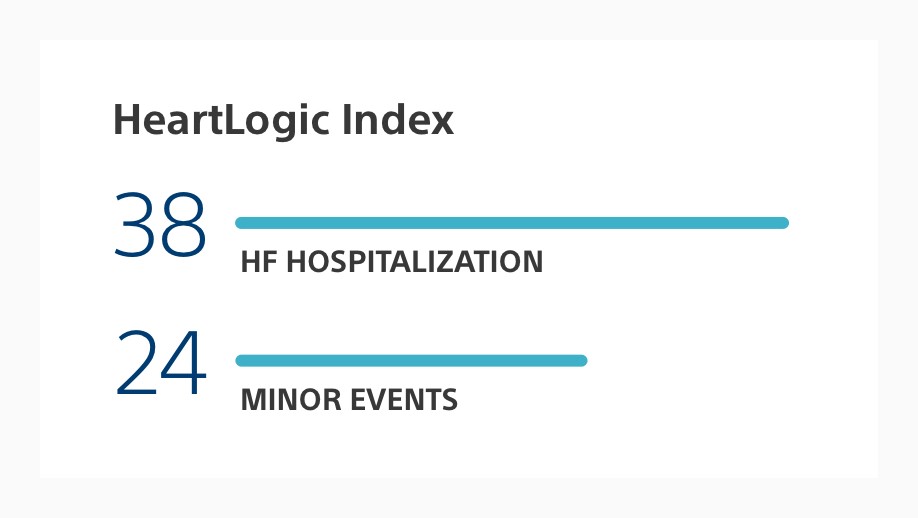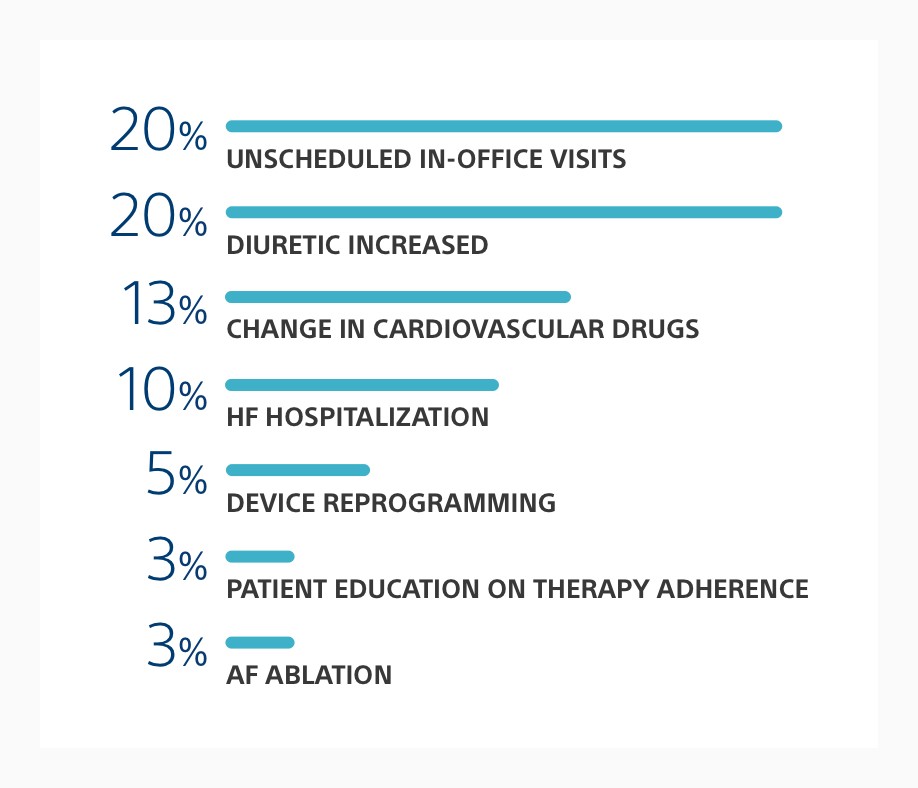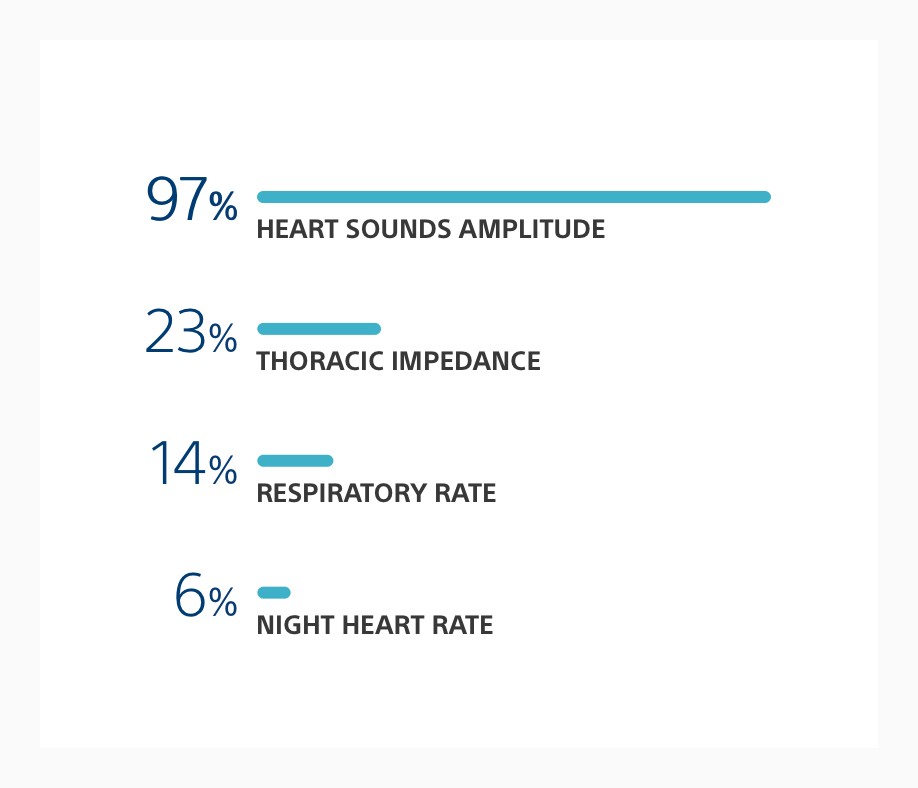HeartLogic Performance in Clinical Practice
HeartLogic™ Heart Failure Diagnostic provided consistent heart failure (HF) detection performance with low unexplained alert rates in real-world analyses of nearly 500 patients across four studies.
| MultiSENSE1 (Validation Data Set) |
Capucci et al.2 (ESC HF 2019) |
Santini et al.3 (Clin Card 2020) |
RE-HEART Phase I4 (ESC HF 2020) |
RE-HEART Phase II5 (ESC HF 2020) |
|
|---|---|---|---|---|---|
| PATIENTS | 400 | 58 | 104 | 104 | 215 |
| FOLLOW-UP (MEDIAN) |
12 months | 5 months | 13 months | 8 months | 5 months |
| HF HOSPITALIZATION RATE (PER PATIENT-YEAR) |
0.20 | 0.21 | 0.15 | N/A | N/A |
| SENSITIVITY | 70% | 100%* | 69%* | N/A | N/A |
| UNEXPLAINED ALERT RATE (PER PATIENT-YEAR) |
1.47 | 0.41 | 0.37 | 0.25 | 0.13 |
| TIME IN HEARTLOGIC ALERT (%) | 17% | 12% | 15% | N/A | N/A |
Retrospective Analysis: Capucci, et al.
Preliminary experience with the multisensor HeartLogic algorithm for heart failure monitoring: a retrospective case series report
In a real-world scenario, HeartLogic alerts preceded heart failure symptoms by a median of 12 days and HF events by 38 days, which demonstrates the opportunity to identify patients earlier in the time course of HF decompensation.2
Pre-Symptomatic Insights6
| Early Warning Time (Days) |
Maximum HeartLogic Index | |
|---|---|---|
| HF HOSPITALIZATIONS | 38 [15-61] | 40 [28-40] |
| HF VISITS | 12 [1-19] | 24 [20-30] |
Sensors with Worsening on the Day of the Alert Threshold Crossing2
| S3 Heart Sounds | S3/S1 Heart Sounds | Night Heart Rate | Thoracic Impedance | Respiration Rate | Rapid Shallow Breathing Index |
|---|---|---|---|---|---|
| 84% | 88% | 60% | 44% | 36% | 36% |
Prospective Analysis: Santini, et al.
Primary Objectives
- Evaluate the clinic workflow of HeartLogic alert management.
- Compare an alert-based, follow-up strategy with scheduled monthly remote transmissions.
- Evaluate the association between HeartLogic alert state and signs and symptoms of worsening heart failure.
Conclusions
- This is the first publication to prospectively evaluate the HeartLogic algorithm in clinical practice utilizing a standardized remote-monitoring protocol.
- This analysis demonstrated HeartLogic alerts to be frequently clinically meaningful and associated with impending HF events.
- The analysis confirmed that the volume of alert-driven, remote follow-ups is low (0.93 per patient-year) when compared with a monthly remote follow-up protocol (10.3 per patient-year) and demonstrates that an alert-based management strategy may be more efficient than a scheduled monthly remote follow-up strategy.
- The probability of detecting common signs and symptoms of HF at regular remote or in-office assessment is extremely low when the patient is out of HeartLogic alert state.
Evaluating the Clinic Workflow of HeartLogic Alert Management
Of the 60 clinically meaningful alerts during the study period, 80% provided new information to clinicians, which highlights HeartLogic’s ability to proactively identify patients at risk.3
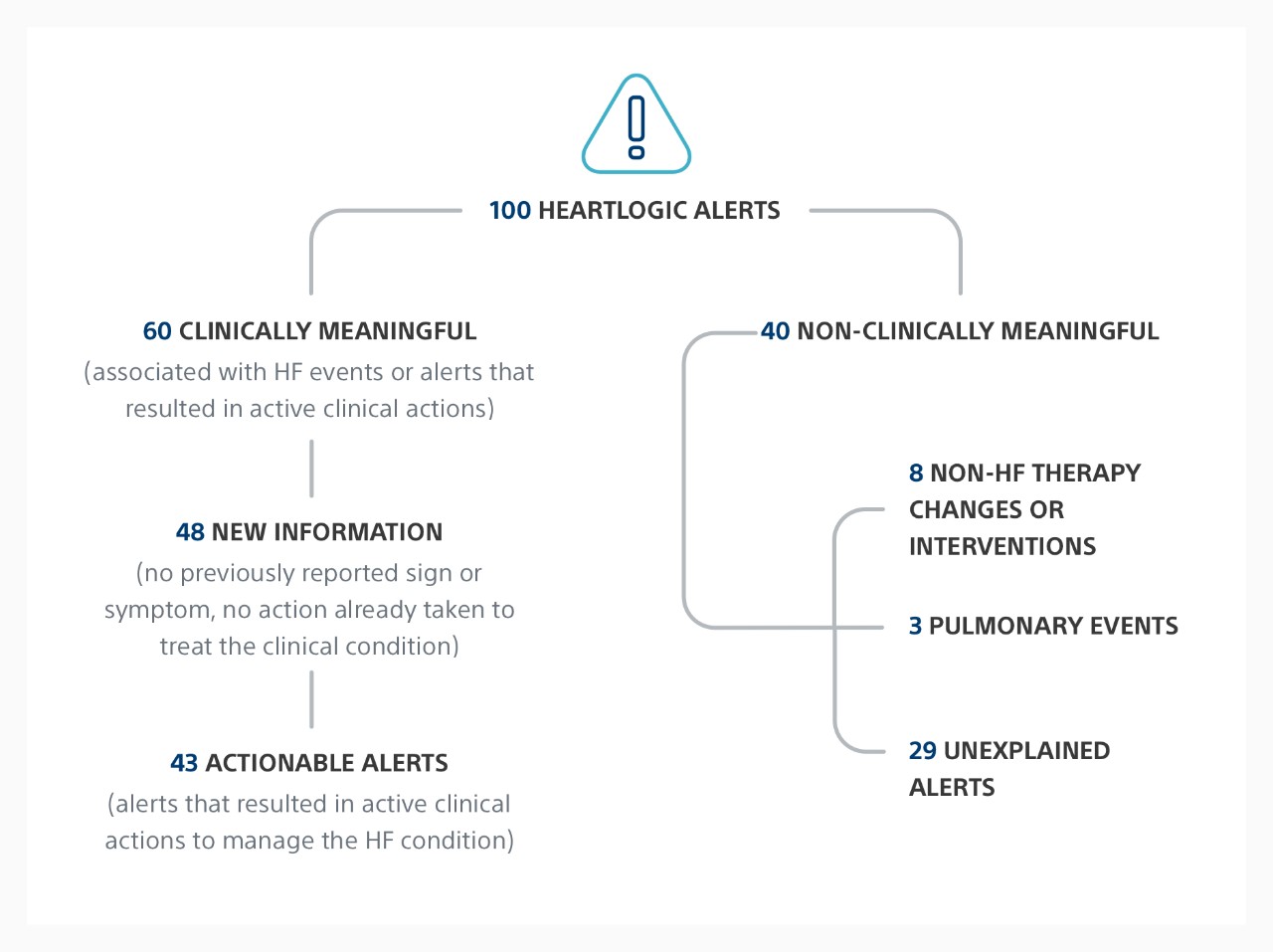
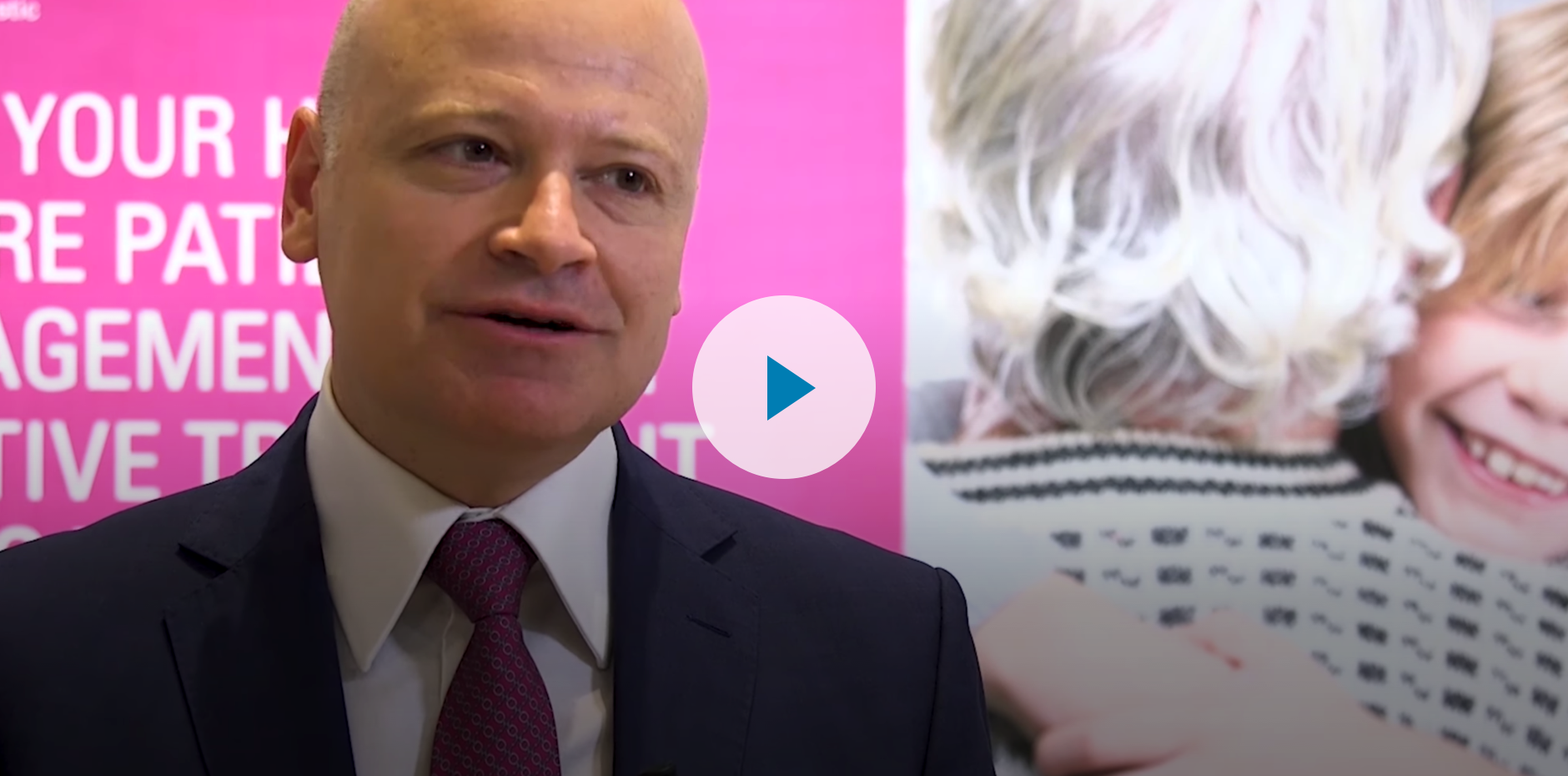
“We learned that HeartLogic is very powerful in stratifying patient with a very low risk. When we have a patient in an out-of-alert condition, we can also give the attention to other patients.”
Luca Santini, MD
RE-HEART Registry Phase I
Preliminary Results of the Spanish Multicentric HeartLogic (RE-HEART) Registry: A Blinded Analysis
Phase 1 of the RE-HEART Registry was a retrospective, blinded analysis designed to analyze the association between clinical events and HeartLogic alerts in patients from 12 Spanish centers.
Maximum HeartLogic Alert Index4
The RE-HEART Registry analysis found a longer duration of alert and higher maximum HeartLogic index for patients with heart failure hospitalizations compared to those with minor events.
RE-HEART Registry Phase II
Preliminary Results of the Spanish Multicentric HeartLogic (RE-HEART) Registry: Adoption of an Alert-Based Heart Failure Management Approach
Phase II of the RE-HEART Registry showed a diverse array of interventions were taken for a diverse patient population. HeartLogic contributing sensors at time of alert were primarily driven by heart sounds.
Sign up for periodic emails and receive a HeartLogic fact sheet to share with your patients’ care teams.
Find out how HeartLogic helps you see patients’ physiologic responses to arrhythmic and pacing changes.
Get results from this global trial evaluating the integration of HeartLogic into clinical practice.
LATITUDE NXT™ Remote Patient Management System: Indications, Safety and Warnings
References
1. Boehmer JP, Hariharan R, Devecchi FG, et al. A multisensor algorithm predicts heart failure events in patients with implanted devices: results from the MultiSENSE study. JACC Heart Fail. 2017 Mar;5(3):216-225. doi: 10.1016/j.jchf.2016.12.011
2. Capucci A, Healey JS. Temporal association of atrial fibrillation with device-based heart failure status in patients with CRT. Oral presentation and LBCT presented at: EHRA Congress; March 2019, Lisbon, Portugal.
3. Santini L, D’Onofrio A, Russo AD, et al. Prospective evaluation of the multisensor HeartLogic algorithm for heart failure monitoring. Clin Card. 2020;43(7):691-697. doi: 10.1002/clc.23366
4. De Juan Baguda J, Gavira Gomex JJ, Pachó Iglesias M, et al. Preliminary results of the Spanish multicentric HeartLogic (RE-HEART) registry: a blinded analysis. Abstract presented virtually at: ESC-HFA Congress 2020.
5. De Juan Baguda J, Gavira Gomex JJ, Pachó Iglesias M, et al. Preliminary results of the Spanish multicentric HeartLogic (RE-HEART) registry: adoption of an alert-based heart failure management approach. Abstract presented virtually at: ESC-HFA Congress 2020.
6. Capucci A, Santini L, Favale S, et al. Preliminary experience with the multisensory HeartLogic algorithm for heart failure monitoring: a retrospective case series report. ESC Heart Fail. 2019 Apr;6(2):308-318. Published online Jan 11 2019. doi: 10.1002/ehf2.12394
*The HeartLogic Index and Alert were validated using data from the MultiSENSE study; however, HeartLogic’s impact on clinical outcome has not been established. Establishment of the impact will require a post market trial designed specifically to study clinical outcomes directly related to the use of this feature.

